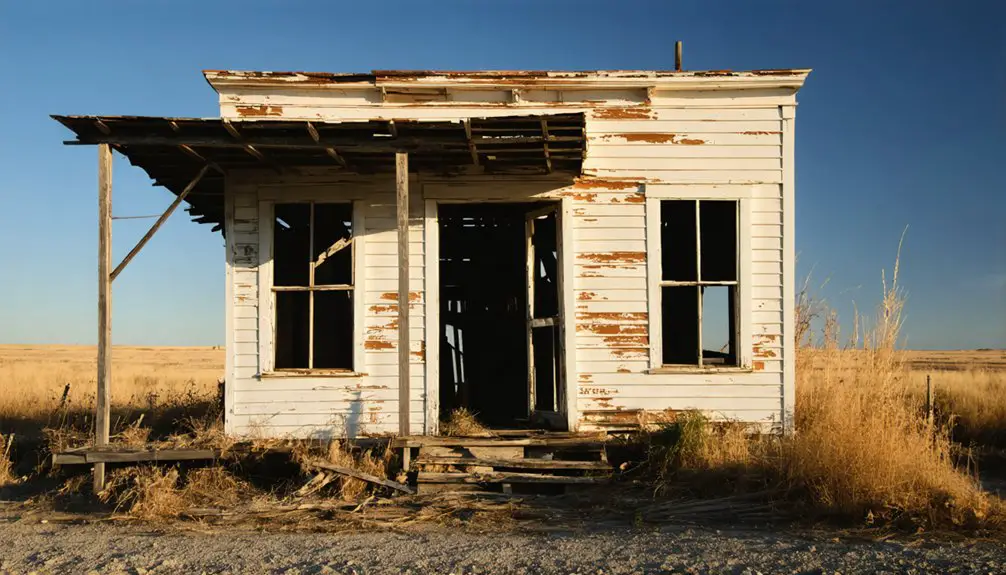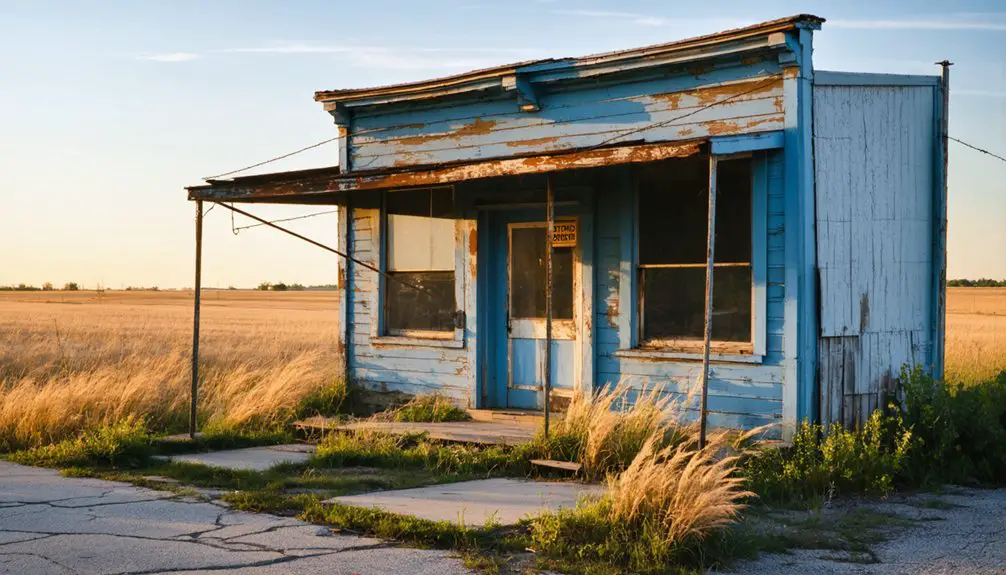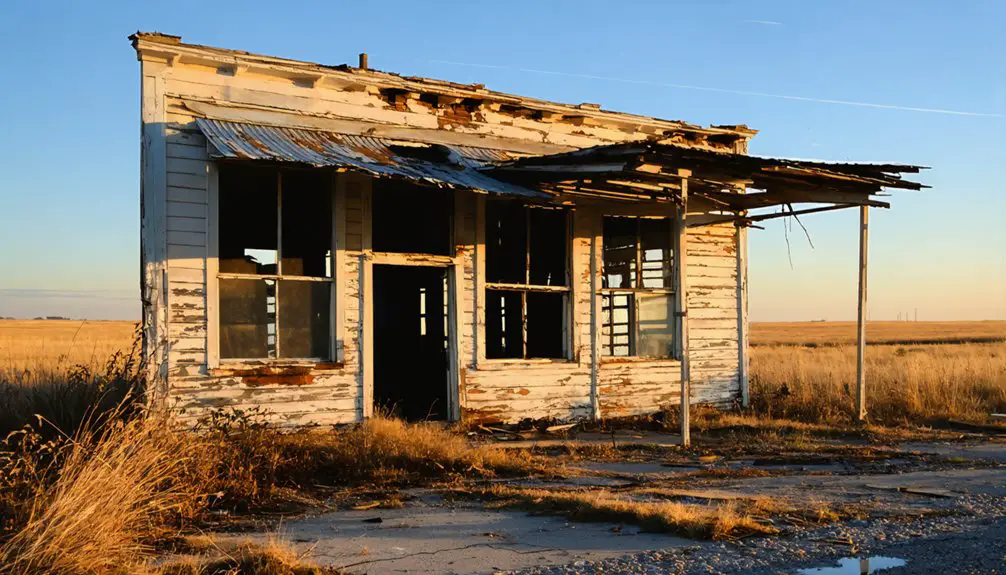You’ll discover Ransomville, Kansas at the intersection of U.S. 50 and Hamilton Road, where J.H. Ransom established a coal mining town in 1881. During its peak in the 1880s, five coal shafts produced 1,000 tons monthly, employing 60 miners in a thriving community of 125 residents. After Ransom’s death in 1914, the mines closed permanently, and today only scattered remnants, including a Victorian home and nearby schoolhouse, hint at deeper stories beneath the surface.
Key Takeaways
- Ransomville was established in 1881 alongside the Santa Fe Railroad, founded by J.H. Ransom as a coal mining community.
- At its peak in the 1880s, the town produced 1,000 tons of coal monthly from five shafts and employed 60 miners.
- The town’s population reached 125 by 1910, featuring essential services like a general store, post office, and schoolhouse.
- Ransomville declined after Ransom’s death in 1914, leading to mine closures and the loss of railway services.
- Today, the ghost town’s mining past is largely erased, with sealed mine shafts and farmland replacing former operations.
The Birth of a Mining Town
When the Atchison, Topeka & Santa Fe Railroad expanded through southwestern Franklin County, Kansas in 1881, it sparked the birth of a promising coal mining settlement called Ransomville.
You’d have found this budding community near the intersection of U.S. 50 and Hamilton Road, where J.H. Ransom leased 40 acres from E.M. Bartholow, later expanding to 320 acres.
As coal mining operations took root, you’d have witnessed the rapid community growth, with about 35 frame cottages springing up to house the miners and their families.
The town soon established essential services – a general store, post office, and school.
Originally from Chautauqua County, New York, J.H. Ransom established himself as a successful businessman before founding the town.
With J.H. Ransom serving as the first postmaster from February 1881, this settlement marked its place on the map, ready to tap into the rich coal deposits beneath its soil. By 1886, the town was thriving with five mining shafts in operation.
James H. Ransom’s Vision
Before establishing Ransomville, James H. Ransom didn’t set out to be a coal magnate. Born in New York in 1836, he’d initially planned for a medical career but found his true calling in business and exploration. His early career included five years in Pennsylvania exploring oil fields. When he arrived in Kansas in 1868, his entrepreneurial spirit led him through several ventures before discovering his destiny in Franklin County.
Ransom’s ambitions went far beyond simple coal mining. You can trace his vision through his methodical approach: first leasing 40 acres, then expanding to 320 acres, and ultimately creating a self-sustaining community. His lasting mark on the area included building a stunning Victorian home in 1889 that still stands today.
He built a mining empire that employed 60 men, established essential services, and even served in the Kansas House of Representatives. His extensive plan transformed a rural patch of Kansas into a thriving coal town that defined the region’s economy throughout the 1880s.
Life in Early Ransomville
Life in early Ransomville revolved around a close-knit community of coal miners and their families who called the town’s 35 modest frame cottages home.
You’d find these mining families gathering at J.H. Ransom’s store, which served as both a commercial hub and social center where neighbors shared news and supplies.
The town’s daily rhythm centered on the coal mines, where about 60 men worked the shafts while their children attended the local public school.
Community events naturally formed around these gathering spots, with the post office and store becoming places where residents could connect.
Like other mining towns in Franklin County, Ransomville benefited from the Coralline marble mining industry that helped sustain local economies.
The Ransomville Speedway became a popular destination for local entertainment and stock car racing events.
By 1910, you’d have found a growing town of 125 people, complete with telegraph service and railroad access.
Despite their simple surroundings, these pioneers built a tight-knit community that supported one another through the challenges of frontier life.
Peak Years of Coal Production
During the peak years of the 1880s, you’d find J.H. Ransom’s five coal shafts churning out an impressive 1,000 tons of coal monthly, with sixty miners working the strip mines, drift mines, and shaft mines.
Like many Kansas coal mining communities of the era, production in Ransomville followed the post-Cherokee deposits pattern seen in districts like Osage City and Pleasanton.
You could spot the coal-laden cars moving along the Atchison, Topeka & Santa Fe Railroad spur, efficiently transporting Ransomville’s prized bituminous coal to enthusiastic buyers.
The town’s mining success transformed the local economy, establishing essential services like a post office, store, and telegraph while positioning Ransomville as Franklin County’s leading coal producer. The mines utilized advanced room and pillar techniques common in other southeastern Kansas operations to maximize coal extraction.
Mining Operations and Scale
Five productive mine shafts marked Ransomville’s flourishing coal operations in the 1880s, each reaching depths of 50 feet beneath Kansas soil.
You’d find miners employing basic mining techniques to extract high-quality coal that J.H. Ransom had first discovered and tested in 1880. After leasing his initial 40 acres, Ransom expanded to 320 acres to support his growing operation.
The scale of production was impressive for its time – you could see about 60 men extracting 1,000 tons of coal monthly by 1886, outproducing all other Franklin County mines combined. While Ransomville eventually vanished like many mining towns, nearby Williamsburg Coal Company helped establish a more enduring community.
The coal quality proved so reliable that the Santa Fe railroad became a steady customer. A windmill kept the shafts operational by pumping out excess water, while 35 frame cottages housed the hardworking mining families.
Transportation and Coal Logistics
While J.H. Ransom’s mines reached peak production, the town’s coal transport infrastructure became a model of freight logistics efficiency. You would’ve seen the Kansas City, Burlington, and Santa Fe Railroad’s dedicated spur line running alongside the mines, enabling seamless distribution across the region. Thirty frame cottages housed the miners who powered these operations.
During the height of operations, you’ll find these impressive numbers:
- Monthly production reached 1,000 tons in 1886
- Five active mine shafts, each 50 feet deep, fed the railway
- District-wide production peaked at 445,000 tons in 1889
The town’s integrated facilities supported this massive operation. You’d have noticed the money order post office, telegraph, and express services working in concert with the railway, while fixed tariff rates streamlined the financial arrangements between miners and railroad companies.
Employment and Economic Impact
At its peak in 1886, Ransomville’s coal mining operations employed a workforce of 60 men who called the bustling town home. You’d find these hardworking miners living in 35 modest frame cottages near the shafts, where they’d extract an impressive 1,000 tons of coal monthly from five 50-foot deep mines.
The employment dynamics shaped Ransomville into the county’s leading coal producer, surpassing all other Franklin County mines combined. You’d witness economic shifts as the town grew to support 125 residents by 1910, with ancillary jobs emerging in the local store, post office, and school.
When James H. Ransom died in 1914, the mines closed, but he’d already begun diversifying the economy by introducing dairy farming with registered Guernsey cattle in 1906.
Daily Life in a Kansas Mining Community
If you lived in a Kansas mining town, you’d spend long days underground extracting coal from narrow 20-inch seams for about $2 per day.
Beyond the physically demanding work, you’d find comfort in the town’s churches, schools, and baseball teams that brought the immigrant community together.
Your housing might come from local homesteaders who opened their doors to miners, creating a makeshift support system in these close-knit but hardscrabble settlements.
Hard Work Underground
Deep beneath the Kansas prairie, coal miners endured grueling conditions as they descended nearly a mile underground each day in personnel carriers called “man-trips.”
You’d find these hardy workers traversing through low-ceilinged tunnels with uneven floors, their paths lit only by artificial light as they wore standard protective gear – coveralls, hard hats, and steel-toed boots.
Despite modern machinery replacing manual tools, workplace hazards remained constant. As you worked, you’d need to stay alert for:
- Rock falls that could strike without warning
- Poor ventilation in the maze-like tunnels
- Long hours of physical labor in damp, dark conditions
Your safety depended on proper equipment, including portable oxygen devices, and the critical support of fellow miners who shared these challenging underground “cities” carved from coal seams.
Community Beyond Coal Mining
While coal mining dominated Ransomville’s economy, the town flourished as a close-knit community of 125 residents by 1910, complete with essential amenities that made daily life possible.
You’d find a bustling post office handling money orders and telegrams, alongside a general store where J.H. Ransom supplied miners and their families with daily necessities.
The town’s farming practices demonstrated remarkable community resilience, particularly when J.H. Ransom diversified into dairy farming with registered Guernsey cattle in 1906.
Children attended the local public school, while families lived in modest frame cottages clustered near the mine shafts.
The Atchison, Topeka & Santa Fe Railroad connected you to the wider world, while independent strip and drift mining operations provided additional employment opportunities beyond the main shaft.
Life in Mining Houses
Living in one of Ransomville’s 35 wood-frame cottages meant adapting to the harsh realities of mining life in 1880s Kansas. Your family’s daily routine would revolve around the mining heritage that defined the community, with fathers and husbands heading to the mines before dawn for grueling 8-12 hour shifts.
Life in these modest homes presented three distinct challenges:
- Managing dampness and poor ventilation due to proximity to mine shafts
- Coping with the constant threat of mining accidents and health risks
- Maintaining household stability during seasonal work fluctuations
Yet community resilience flourished as mining families formed tight bonds through shared experiences. Women managed households while children attended nearby schools, creating a self-reliant culture despite the hardships.
You’d find comfort in the close-knit nature of these mining cottages, where neighbors supported each other through the uncertainties of mining life.
The Railroad’s Vital Role
Since its establishment in 1881, Ransomville’s destiny was inextricably linked to the Atchison, Topeka & Santa Fe Railroad line that ran through its heart.
You’d have witnessed railroad expansion transforming this modest settlement into a bustling coal town, as James H. Ransom leveraged his railroad contracting experience to overcome logistics challenges in the region.
The railroad’s presence wasn’t just convenient – it was revolutionary. By 1886, you could’ve seen roughly 1,000 tons of coal being shipped monthly, surpassing all other Franklin County mines combined.
The railway didn’t just move coal; it breathed life into the community. Telegraph services, express shipping, and a strategic layout of miners’ cottages near the tracks created a thriving hub where about 60 miners and their families built their lives.
Disasters That Shaped the Town

Mining accidents and hazards plagued Ransomville’s coal operations, with underground cave-ins and dangerous explosions threatening miners’ lives throughout the town’s active years.
You’ll find that the mine shafts, requiring constant water pumping to prevent flooding, eventually succumbed to permanent closure following James H. Ransom’s death in 1914.
The town’s final blow came as the Santa Fe railroad line was removed, severing essential transportation links that had once made Ransomville a bustling coal camp.
Devastating Fires Strike Hard
Although Ransomville’s specific fire history remains sparsely documented, the town’s wooden structures and coal mining activities made it particularly vulnerable to devastating blazes that plagued similar communities in Kansas during the late 19th and early 20th centuries.
You’ll find the ever-present fire hazards took a severe toll on mining towns’ community resilience, as demonstrated by these critical vulnerabilities:
- Frame cottages built close together allowed fires to spread rapidly through the settlement.
- Limited firefighting capabilities left residents dependent on bucket brigades and basic equipment.
- Lack of proper water infrastructure and fire hydrants made containing large blazes nearly impossible.
When fires struck nearby Williamsburg in 1890, destroying half the town, it served as a stark reminder of the constant threat these isolated mining communities faced.
The economic impact often proved insurmountable, accelerating many towns’ decline into abandonment.
Multiple Mining Shaft Collapses
Beyond the ever-present fire hazards, Ransomville’s coal mines harbored even deadlier threats beneath the surface. You’d find five major shafts plunging 50 feet deep, where 60 brave miners extracted 1,000 tons of coal monthly.
But the unstable geology couldn’t support these massive underground tunnels, leading to devastating cave-ins that claimed lives and destroyed livelihoods.
The environmental impacts were severe – sinkholes swallowed farmland, while hidden shafts reopened during heavy rains, creating new hazards years after abandonment.
Though mining regulations came too late for Ransomville, the state’s Abandoned Mine Land Program has since filled hundreds of dangerous openings.
Still, the legacy of these collapses lives on, having contributed to the town’s extinction by 1915 when the mines finally closed following Ransom’s death.
Railroad Service Gradually Disappears
When the Atchison, Topeka & Santa Fe Railroad first laid tracks through Ransomville, you’d find a bustling coal town where freight cars hauled away 1,000 tons of black gold monthly.
The railroad’s decline began after James H. Ransom’s death in 1914, delivering three devastating economic impacts:
- Coal mine closures eliminated the primary freight cargo
- Telegraph and express services ceased operations by 1915
- Regular rail traffic dwindled as shipping demand evaporated
You’d witness the Santa Fe Railroad gradually reducing services as automobiles and trucks emerged as preferred transportation.
Without coal shipments generating revenue, the railroad couldn’t justify maintaining the line through Ransomville.
The disappearance of rail service stripped away your town’s essential transportation artery, accelerating its transformation into another Kansas ghost town.
The End of an Era

After James H. Ransom’s death in September 1914, you’d witness the final chapter of a once-thriving mining town.
Despite attempts at economic diversification through Ransom’s Guernsey dairy cattle venture in 1906, the mines’ closure dealt a devastating blow, leaving 60 miners suddenly jobless.
The town’s community resilience was tested as its population, which had peaked at 125 residents in 1910, rapidly dwindled.
What Remains Today
The haunting emptiness of Ransomville’s former townsite reveals little trace of its mining-era glory.
Time has erased Ransomville’s mining legacy, leaving only quiet fields where a vibrant community once stood.
You’ll find the ghost town remnants have largely vanished, replaced by an agricultural transformation that’s swept across the rural Kansas landscape.
Today, scattered farmhouses and fields dominate where a bustling coal mining community once thrived.
If you visit the site, located two miles northeast of Williamsburg, you’ll discover:
- No original structures remain intact, though a small white schoolhouse stands nearby
- The Santa Fe Railroad tracks have been completely removed, erasing this essential transportation link
- Former mining shafts are now sealed and covered, with farmland stretching across their previous locations
The area’s story lives on primarily through historical records rather than physical landmarks, making it a true ghost town of Kansas’s mining era.
Preserving Ransomville’s Memory

Despite Ransomville’s physical structures fading into Kansas farmland, dedicated preservation efforts maintain the town’s memory alive through various initiatives.
You’ll find local historical societies actively documenting the coal mining heritage through photographs, maps, and oral histories, while collaborating with state history clubs to integrate Ransomville into broader Kansas ghost town preservation projects.
The town’s memory preservation continues through digital archives, historical texts, and county records that detail its mining operations and daily life.
You can explore Ransomville’s story through educational programs at local schools, libraries, and public talks.
While you won’t find many physical remnants today, community involvement guarantees the town’s legacy through historical markers near U.S. 50 highway and Hamilton Road, where interested visitors can still connect with this piece of Kansas history.
Frequently Asked Questions
What Were the Average Wages of Miners in Ransomville During the 1880S?
You’d have earned about $1.50 per ton mining coal, with your average salaries varying based on mining conditions and how much you could extract from the relatively shallow 50-foot shafts.
Were There Any Major Mining Accidents or Fatalities Recorded in Ransomville?
You won’t find any major mining accidents or fatalities in historical accident reports from Ransomville. While mining safety hazards existed, documentation shows no large-scale disasters at this smaller operation.
What Happened to the Mining Equipment After the Town Was Abandoned?
Time swallows all things. You’d find most mining equipment was either salvaged after the 1914 closure or left to rust, though the windmill survived and was repurposed for farming in this ghost town.
Did Any Notable Historical Figures Ever Visit or Stay in Ransomville?
You won’t find records of any famous visitors or historically significant figures staying in Ransomville. Beyond founder James H. Ransom, the town’s legacy centers purely on its coal mining community.
Were There Any Native American Settlements in the Area Before Ransomville?
You’ll find the area’s tribal history included Kansa and Osage peoples, with later Ottawa settlements nearby. While Native Americans traversed the region, there weren’t permanent villages directly where Ransomville stood.
References
- https://legendsofkansas.com/ransomville-kansas/
- https://www.humanitieskansas.org/get-involved/kansas-stories/places/mining-for-stories-in-a-kansas-ghost-town
- https://abandonedkansas.wordpress.com/2022/02/02/ransomville-kansas/
- https://dianastaresinicdeane.wordpress.com/2011/12/23/o-little-town-of-williamsburg/
- http://fcrhc.blogspot.com/2018/06/ransomville.html
- https://esirc.emporia.edu/bitstream/handle/123456789/1579/Reekie Vol 8 Num 3.pdf?sequence=1
- https://legendsofkansas.com/franklin-county-extinct-towns/
- https://www.findagrave.com/memorial/8563683/james-harvey-ransom
- http://www.ksgenweb.org/archives/1912/r3/ransom_james_h.html
- https://keep.konza.k-state.edu/handbookdocuments/Early Kansas Settlement – 2012.pdf



